After nearly 3 years of work, 13 Firefox releases, 6 milestones and a lot of bits flipped, I’m happy to announce that the project of integrating the Fluent Localization System into Firefox is now completed!
It means that we consider Fluent to be well integrated into Gecko and ready to be used as the primary localization system for Firefox!
Below is a story of how that happened.
3 years of history
At Mozilla All-Hands in December 2016 my team at the time (L10n Drivers) presented a proposal for a new localization system for Firefox and Gecko – Fluent (code name at the time – “L20n“).
The proposal was sound, but at the time the organization was crystallizing vision for what later became known as Firefox Quantum and couldn’t afford pulling additional people in to make the required transition or risk the stability of Firefox during the push for Quantum.
Instead, we developed a plan to spend the Quantum release cycle bringing Fluent to 1.0, modernizing the Internationalization stack in Gecko, getting everything ready in place, and then, once the Quantum release completes, we’ll be ready to just land Fluent into Firefox!
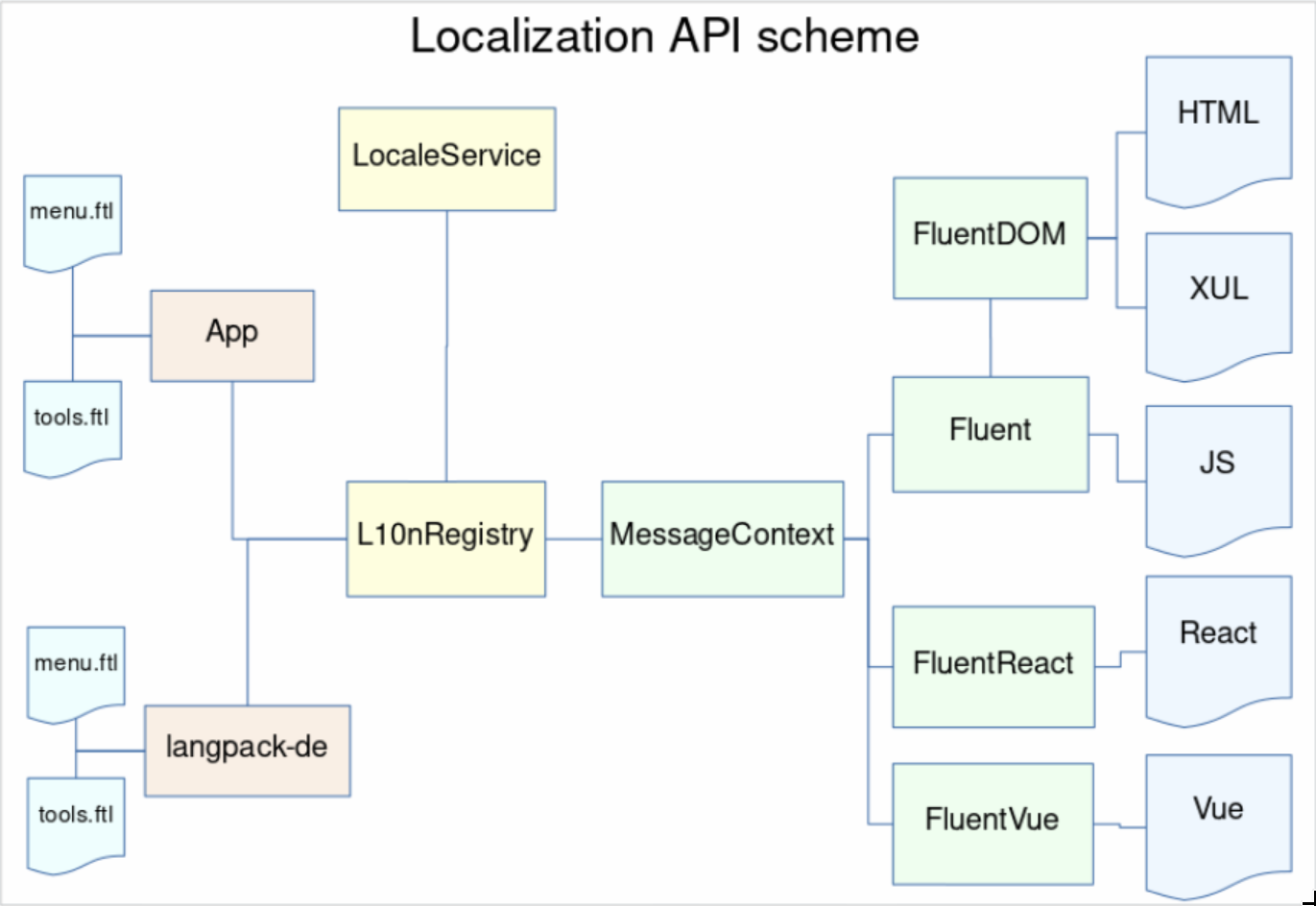
We divided the work between two main engineers on the project – Staś Małolepszy took the lead of Fluent itself, while I became responsible for integrating it into Firefox.
My initial task was to refactor all of the locale management and higher-level internationalization integration (date/time formatting, number formatting, plural rules etc.) to unify around a common Unicode-backed model, all while avoiding any disruptions for the Quantum project, and by all means avoid any regressions.
I documented the first half of 2017 progress in a blog post “Multilingual Gecko in 2017” which became a series of reports on the progress of in our internationalization module, and ended up with a summary about the whole rearchitecture which ended up with a rewrite of 90% of code in intl::locale component.
Around May 2017, we had ICU enabled in all builds, all the required APIs including unified mozilla::intl::LocaleService, and the time has come to plan how we’re going to integrate Fluent into Gecko.
Planning
Measuring
Before we began, we wanted to understand what the success means, and how we’re going to measure the progress.
Stating that we aim at making Fluent a full replacement for the previous localization systems in Firefox (DTD and .properties) may be overwhelming. The path from landing the new API in Gecko, to having all of our UI migrated would likely take years and many engineers, and without a good way to measure our progress, we’d be unable to evaluate it.
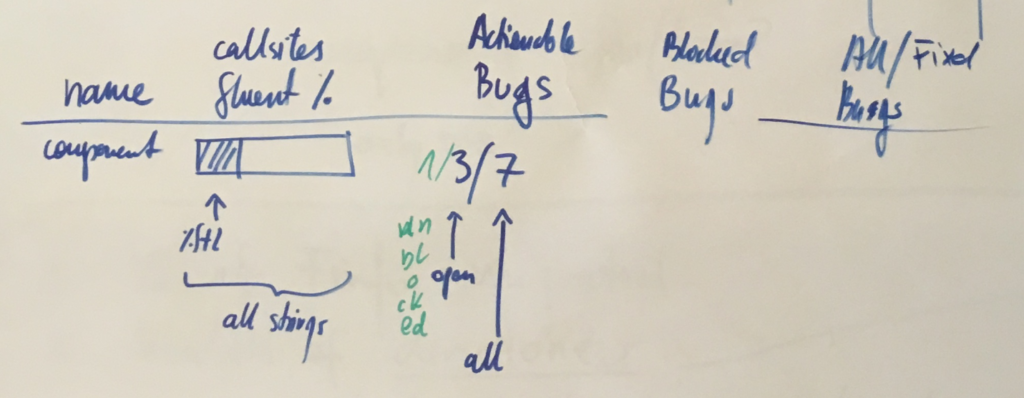
Together with Axel, Staś and Francesco, we spent a couple days in Berlin going back and forth on what should we measure. After brainstorming through ideas such as fluent-per-component, fluent-per-XUL-widget and so on, we eventually settled on the simplest one – percentage of localization messages that use Fluent.

We knew we could answer more questions with more detailed breakdowns, but each additional metric required additional work to receive it and keep it up to date. With limited resources, we slowly gave up on aiming for detail, and focused on the big picture.
Getting the raw percentage of strings in Fluent to start with, and then adding more details, allowed us to get the measurements up quickly and have them available independently of further additions. Big picture first.
Staś took ownership over the measuring dashboard, wrote the code and the UI and soon after we had https://www.arewefluentyet.com running!
Later, with the help from Eric Pang, we were able to improve the design and I added two more specific milestones: Main UI, and Startup Path.
The dashboard is immensely useful, both for monitoring the progress, and evangelizing the effort, and today if you visit any Mozilla office around the World, you’ll see it cycle through on the screens in common areas!
Target Component
To begin, we needed to get agreement with the Firefox Product Team on the intended change to their codebase, and select a target for the initial migration to validate the new technology.
We had a call with the Firefox Product Lead who advised that we start with migrating Preferences UI as a non-startup, self-contained, but sufficiently large piece of UI.
It felt like the right scale. Not starting with the startup path limited the risk of breaking peoples Nightly builds, and the UI itself is complex enough to test Fluent against large chunks of text, giving our team and the Firefox engineers time to verify that the API works as expected.
We knew the main target will be Preferences now, but we couldn’t yet just start migrating all of it. We needed smaller steps to validate the whole ecosystem is ready for Fluent, and we needed to plan separate steps to enable Fluent everywhere.
I split the whole project into 6 phases, each one gradually building on top of the previous ones.

Phase 1 – Soft Launch (May 2017 – November 2017)
In this phase we intent to introduce a single, new, trivial message using Fluent into Firefox. That will require all core systems, like LocaleService, Intl, L10nRegistry, Fluent, Fluent-DOM, and Fluent-Gecko to work,. On top of that, we’ll need compare-locales, and Pontoon support. In this phase we will intentionally keep the new API under control with a whitelist of enabled .ftl files to remove the risk of engineers starting to use our API prematurely.
Bug 1402061 – Soft-launch the new localization API

Introducing a new localization system is already a huge challenge and if we caused regressions, it’d be much harder to get a buy-in from the organization for the future work. We needed that trust, and had to be careful not to lose it.
With an aim at migrating all eleven thousand strings in Firefox to Fluent, having a whole phase devoted to migrating just one may seem an overkill, but we wanted to start very small and be very careful.
The first phase landed just a single string in our JavaScript code, behind a flag intl.l10n.fluent.disabled, which we could flip on/off.
It’s easy to underestimate how much ecosystem alignment work is needed, and a milestone like this is a great way to expose it.
In order to complete this milestone, we had to remodel our language packs, localization tools, build system and other bits. A lot of small and medium size blockers were discovered quite late in the cycle contributing to a close to 6 weeks delay and a total time of 3 months to migrate a single string!
Eventually, the string landed in Firefox 58 and while itself it may seem like a small patch, the dependency tree of changes that were required to get there, tells a different story.
In the end, with support from Axel Hecht and Matjaz Horvat, we were able to complete this cycle in time for Firefox 58 train, and move on to the next one!
Phase 2 – First Migration
In this phase we will migrate the first piece of UI to Fluent. It will be a stable and fairly hidden piece of UI that is unlikely to change within months. We’ll also want the strings involved to be as simple as possible. This phase will test our migration infrastructure in Fluent, Gecko and Pontoon.
Bug 1407256 – First-migration release for the new localization API

In Phase 1, we added a string. But with close to 11 thousand strings in Firefox, migration of existing strings was known to be a substantial task on its own.
Staś wrote a new application devoted to facilitate migration by applying “migration recipes”. It works like this: First, we write a patch that migrates the strings and callsites in our codebase. Then, we generate a small python script that is later used by the migration application to take existing translations from all 100+ locales and place them in the new Fluent files.
The intended result is that we can migrate from the old systems to the new one without asking our localizers to manually re-translate all new strings that appear in result of it!
In Firefox 59, we migrated 5 strings from DTD to Fluent, and successfully applied the produced migration recipe onto all locales Firefox is translated in!
Phase 3 – Preferences
In this phase, we will migrate a single, complex, component off the start up path – Preferences. It’ll require us to prove Fluent integration with Intl, and Pontoon handling of more complex FTL features. We will be closely working with the most senior Firefox Front-End Team engineers as reviewers and reacting to their feedback on missing and required features in Fluent.
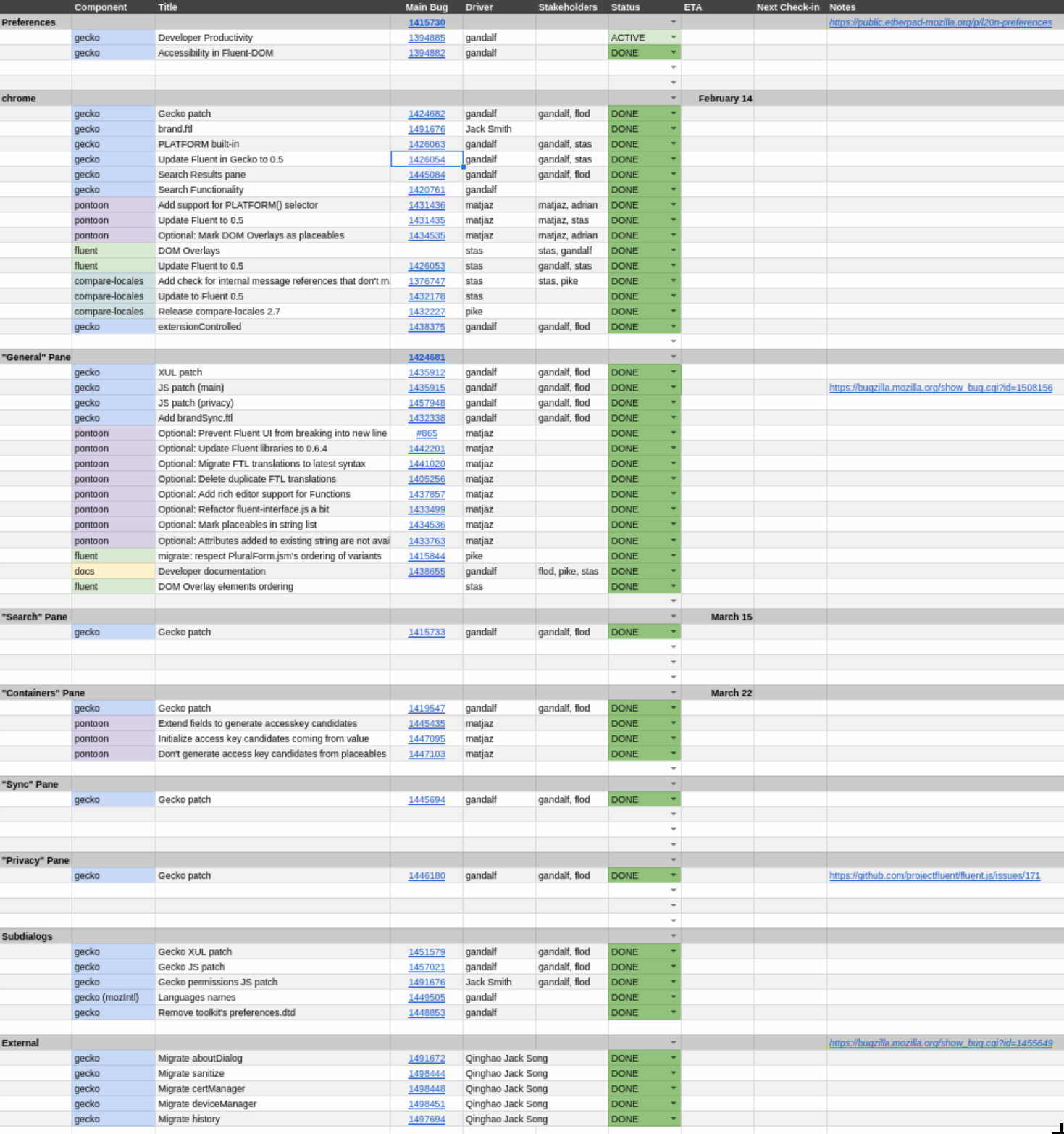
The jump between Phase 2 and Phase 3 was quite massive – from 5 strings to ~1600. Preferences UI is a text-heavy, large component which is important for a regular user experience and any regression in this area will be considered critical.
As you can see from the outline, this phase was divided into a very large number of bugs that were tracked separately and depending on which of the Fluent features a given part of the UI used, had different dependencies and blockers.
The area of concern in this phase shifted back from refactoring the ecosystem, bindings and tooling, back to the core of Fluent as we needed to finalize many of its features such as DOM Overlays, PLATFORM selector, and update Fluent itself to 0.6.
With the flock of new strings landing into our repository, Pontoon – our web localization platform – had to add support for many of the Fluent features that now became used in production.
This phase was particularly long, as we were monitoring the impact of our changes and fine-tuning the whole network of tools with each piece of UI migrated, but in the end, we were able to migrate all of the Preferences to Fluent, significantly simplify the localization API usage, and maintain the performance characteristics.
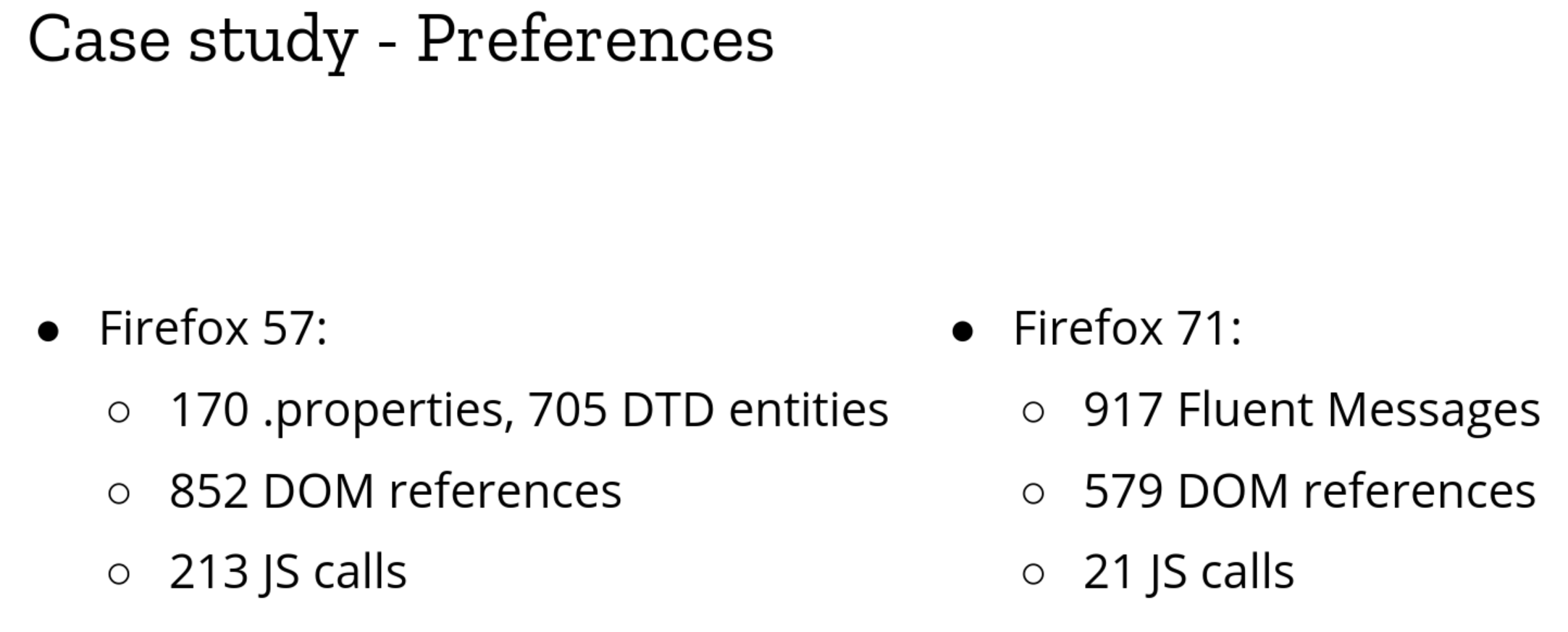
The most impressive number here is the 10 fold reduction of JS calls. That means that we removed 180 places where JS code had to retrieve a string and push it to the UI, replacing all of them with declarative bindings. Declarative bindings are much less error prone, easier to handle asynchronously, and maintain with tools.
Firefox 62 shipped with over 1600 Fluent strings into production!
Phase 4 – Open Migration
In this phase we will start migrating more pieces of Firefox front-end to Fluent one by one. All work will be tightly monitored by the L10n Drivers team to allow us to evaluate readiness of our system for each component, postpone it if needed, and adjust the speed of transition on the go.

After Firefox 62, we started two phases in parallel.
Phase 4 – Open Migration – we intended to build up on the work we’ve done in Phase 3.
With over 1600 strings migrated, we started cleaning up our integration code and bringing more of the code deep into the DOM API. In particular, we integrated the main entry point for the Fluent – document.l10n – into our Document WebIDL, making it available to all internal UI documents.
Knowing that we can migrate large chunks of strings as complex as ones we encountered in Preferences, we were able to continuously migrate batches of strings, and extend Fluent coverage to other areas of Firefox UI such as System Add-Ons, and non-privileged documents (about:neterror etc.).
At the same time, my focus shifted to the most challenging phase – Phase 5.
Phase 5 – Startup Path
In this phase we expect to be ready to enable Fluent on the startup path of Firefox. This phase may happen at the same time as the previous one, but if we encounter delays, we can specifically postpone this one without blocking the previous one.
Bug 1441035 – Improve performance of Fluent on the startup path

Despite how small the outline is, we knew that Phase 5 will be the longest and most challenging one.
We had one goal here – enable Fluent on the startup path without regressing performance.
Previous localization systems were very simple and well integrated into Gecko. Over 10 years of performance profiling and optimizations led to very tight and optimized codepaths for DTD and Properties, that we had to now replicate with Fluent, in order to enable use of Fluent on the startup path.
Initial Fluent numbers, even from before we started this project, indicated 15-30 ms performance regression on the startup, and performance profiling indicated that majority of that comes from using JavaScript for applying translation onto DOM.
JavaScript was a very good choice for the prototyping phase of Fluent, but with the shift from design, to implementation phase, we had to remove the cost of calling JS from C++ and C++ from JS.
The bulk of the work went into migrating all pieces of Fluent which interact with the DOM to C++. On top of that, with the help from Dave Townsend and Olli Pettay I was able to hook Fluent localization cycle into XUL cache to get on par with what DTD was doing.
There was one more tricky piece to add. Originally, per request from Benjamin Smedberg, Fluent was designed to be fully asynchronous, but during a design brainstorm on the startup path model with Boris Zbarsky, he asked me to add a synchronous mode which would be used just for the startup path.
The rationale is that while having localization resources I/O not block UI makes sense in almost all cases, there is no reason to delay I/O for the resources needed to paint the initial UI.
Fortunately, adding synchronous mode (triggered by setting data-l10n-sync attribute on the root element of the document) to an asynchronous code is much easier than doing the reverse, and with the help from Axel Hecht, I was able to get this dual-mode to work!
In the end, this phase took close to a year, and we finally completed it in August of 2019, enabling the first strings in the main browser UI to be migrated away from DTD to Fluent!
Phase 6 – Full Launch
In this phase we will remove the whitelist and let the developers start using the new API. We’ll still monitor their work and will ask for a period of adding us as reviewers on any patch that uses the new API, until we gain confidence in the new system.

With Fluent available and tested in various major pieces of Firefox UI such as Preferences, startup path, privileged and non-privileged documents and add-ons, Phase 6 allowed us to wrap up the lose ends and tighten the experience of working with Fluent.
We improved error messages, tests, and migration recipes, and continuously migrated more of Firefox UI to Fluent with increasing confidence that the system holds well and is a capable replacement for the older systems.
Finally, in November, we decided that the remaining items in Phase 6 are not of high priority, and with ~75% of DTD strings removed, and close to 4000 Fluent strings in place, we announced deprecation of the DTD as a localization system in Firefox. That, symbolically, marked the completion of this project!
Takeaways
Here’s a subset of the lessons learned we accumulated from our post-mortems organized at the end of each of the six phases:
- Start with a very small and well defined milestone.
- Keep an up-to-date single-view dashboard of project status to align stakeholders
- Hold kick-off and post-mortem meetings even if it seems mundane. They create space for stakeholders to improve the process.
- Be vocal about delays. They accumulate fast in the phantom traffic jam model.
- Syntax changes against in-production code are much harder than API changes.
- When working cross-team, document everything. External stakeholders are driven toward well-documented projects.
- Divide large project into small phases in an exponential rather than linear model.
- Landing a major in-development project into Gecko over a 3 year span is very challenging. There’s movement below (Gecko is a moving target) and above (Fluent was a moving target). Integration ends up being a very delicate task.
- The best technology stack for prototyping is likely not going to be the best stack for production. Make decisions about how you’re going to handle that.
Next steps
Today, we have only 1100 DTD strings left from the original ~4000, and are focused on removing the 500 of them which are still on the startup path.
This is not the end of work yet as both Fluent development and its integration into Firefox are active, but it is a symbolic milestone for all those involved as we now completed a task that we clearly defined for ourselves in December 2016, and it is a rare occurrence in the software engineering realm for a project to stay on track for so long and deliver a closure in line with the original expectations.
We’re also bringing Fluent as an input proposal to the newly formed Unicode Message Format Working Group, with the hopes of working with the whole industry to develop a future Unicode Standard.
In Firefox, in 2020 we hope to eradicate all of DTD calls, bring new features to Fluent, deprecate .properties, migrate Fluent in Gecko to fluent-rs, and start building new capabilities that become possible when our engine uses a single, modern, unified localization system. Onwards!
Experience
It was an exciting and challenging project. It spanned from the beginning of 2017 till the end of 2019, and challenged me in many new ways.
I had to design a multi-stage, multi-year roadmap, coordinate the effort between multiple teams and people which impacted high number of modules of a product installed on hundreds of millions of machines, keep track of progress of work for many engineers on various teams such as build system, add-ons, DOM, performance, front end, security, l10n etc., run post-mortems for each phase and balance the workload while ensuring minimal time is spent being blocked.
In parallel, Staś had to plan and lead the standardization of the Fluent syntax and the implementation of the API. The parallelism of those two efforts was both a blessing and a curse for us.
Having a tight-loop in which we were able to test the revisions against production helped us avoid conceptual rabbit holes and also helped us shape Fluent much faster. At the same time the growing number of strings that already used Fluent in Firefox became an increasingly strong factor limiting our decisions and forcing us to make sub-optimal compromises from the design perspective, just to avoid having to refactor all the already-in-production bits that relied on the earlier prototypes.
While the project was challenging on many fronts, encountered numerous delays and each post-mortem collected many lessons-learned and next-time, I’m really happy that the roadmap designed in the end of 2016 worked without any major changes all the way till the completion 3 years later, and all stakeholders reported positive experience of working on it and called it a success!
To recognize that achievement, we’re going to hold a small celebration at the upcoming Mozilla All Hands in Berlin!
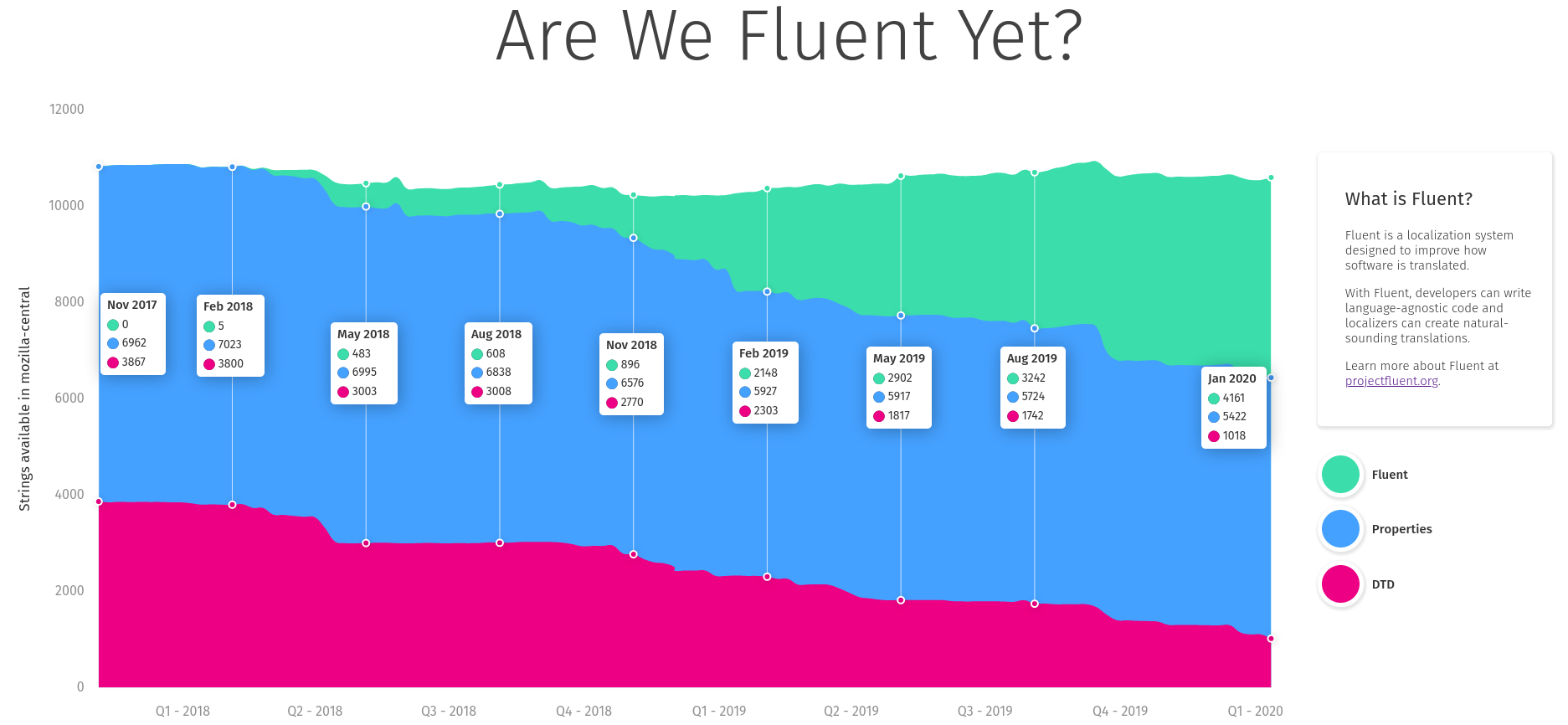
2 replies on “The New Localization System for Firefox is in!”
[…] The New Localization System for Firefox is in! […]
Wow! What an effort. Well done 👏👏👏